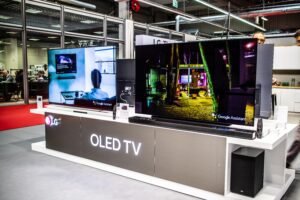Table of content
1. Introduction
When selecting a high-end TV, two advances to consider are OLED vs QLED. Both offer predominant picture quality compared to conventional LED/LCD TVs but utilize diverse innovations for amazing visuals. This article investigates the key contrasts between OLED vs QLED TVs, their aces and cons, and how to select the leading fit for your seeing preferences.
2. What is OLED?
OLED stands for Natural Light Emanating Diode. Not at all like conventional Driven or QLED TVs that require a backdrop illumination to show pictures, has each pixel in an OLED board radiated its claim light. This permits for more profound blacks and prevalent differentiate as person pixels can turn off totally in dim scenes, coming about in boundless contrast.


-
How it Works
OLED TVs utilize natural compounds that radiate light when an electric current pass through them. Each pixel in an OLED show produces its claim light and can be turned on or off freely. This permits OLED TVs to realize idealize blacks and unbounded differentiate proportions since dark pixels are totally turned off, coming about in no light emission.
Advantages:
-
Idealize Dark Levels
OLED TVs can create genuine dark by turning off person pixels, coming about in predominant differentiate and wealthier colors.
-
Wide Seeing Points
OLED boards offer great seeing points, so colors and differentiate stay reliable indeed when seen from the side.
-
Lean and Adaptable
OLED shows can be made amazingly lean and indeed bended, advertising smooth plans and special frame factors.
Disadvantages:
-
Hazard of Burn-in
OLED shows are vulnerable to burn-in, where inactive pictures can take off a lasting phantom picture on the screen in the event that shown for expanded periods.
-
Constrained Brightness
Whereas OLED TVs can accomplish fabulous differentiate, they may not reach the same crest brightness levels as a few QLED models, which can affect HDR execution in brightly lit rooms.
2. What is QLED?
QLED stands for Quantum Dot LED. It’s a frame of Driven innovation that utilizes quantum dabs to improve execution in ranges like brightness and color. A QLED TV employments a Driven backdrop illumination but includes quantum specks before it. When the Driven backdrop illumination sparkles through these days, they deliver more dynamic colors and higher brightness levels than conventional LEDs.
-
How it Works
In the race of OLED vs QLED. QLED TVs utilize a backdrop illumination that sparkles through a layer of quantum specks, which are semiconductor nanocrystals that can emanate diverse colors of light depending on their measure. These quantum dots are arranged before the backdrop illumination and can be absolutely controlled to produce dynamic colors and expanded brightness.
Advantages:
-
Brightness
QLED TVs can accomplish exceptionally tall crest brightness levels, making them perfect for seeing in well-lit rooms or HDR content.
-
No Hazard of Burn-in
Not at all like OLED vs QLED TV boards don’t endure from burn-in issues, making them more reasonable for gaming or showing inactive substance for expanded periods.
-
Color Exactness
QLED TVs regularly offer great color precision and can create a wide color array, coming about in striking and similar images.
Disadvantages:
-
Constrained Differentiate
Whereas QLED TVs can accomplish amazing brightness levels, they may battle to realize the same profound blacks and differentiate proportions as OLED shows, particularly in dim room environments.
-
Smaller Seeing Points
QLED boards may involvement color and differentiate debasement when seen from off-angles, making them less reasonable for wide seating arrangements.
Conclusion
Choosing between OLED vs QLED depends on what you prioritize in a TV. In case you esteem unparalleled picture quality, profound blacks, and a wide seeing point, and are affirm with the next or potential burn-in issues, then OLED may be the correct choice. On the other hand, in case you incline toward a TV that handles encompassing light well, gives dynamic colors, higher brightness levels, and is less inclined to burn-in, all whereas being for the most part more reasonable, at that point QLED may well be way better alternative. Both advances offer great viewing experiences, and your individual propensities and environment will impact your choice.


